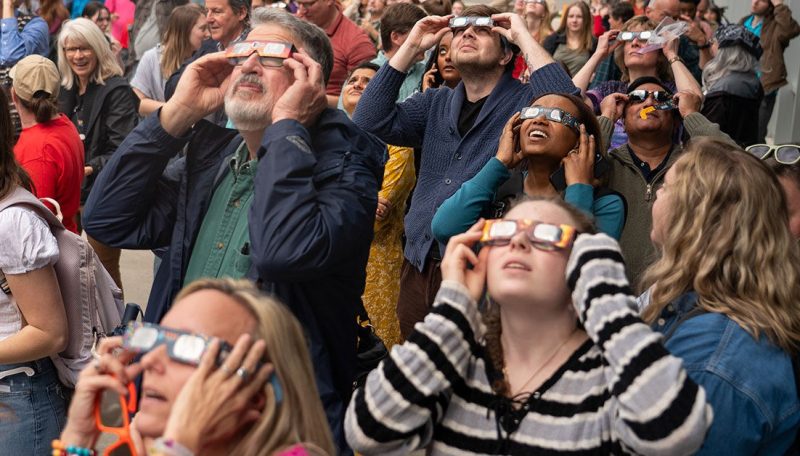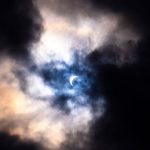

RADFORD – Cleanup in the scene shop can wait when there is a much bigger event taking center stage, high above the Earth.
“We were at work and thought, ‘Wait, this could be way more interesting,’” said Angelina Capots, a sophomore theatre major from Fredericksburg, about the partial solar eclipse hanging over the Radford University campus.
Capots and a group of theatre majors, along with their instructor Kate Burnham-Hull, had been tidying up from a recent musical on campus when they decided to take a break and scurry outside in the early afternoon on April 8 to join hundreds more Highlanders and community members gathered on the Artis Center for the Sciences patio and parking lot, all hoping to catch a glimpse of the rare solar occasion.
“We didn’t want to miss out on that because it is such a cool event,” Capots said.
Heavy cloud cover over a 64-degree day in Radford nearly spoiled the show.
“My weather app says the clouds may clear a little,” a hopeful skywatcher said.
And they did clear somewhat. Three or four times throughout the afternoon, the clouds scattered apart briefly, and the sun and moon played peek-a-boo with those starring up from below.
One of the times was at near-peak solar coverage. At 3:10 p.m., umbraphiles-for-a-day slid over the eyes of their university-provided solar glasses, lifted their heads skyward and uttered a collective and loud “ooooooh!” at the awe-inspiring event.
“I was blown away, to be honest. I was speechless,” Jasmine Graham, a sophomore from Richmond, Virginia, said moments later.
As the eclipse reached its pinnacle, which was about 87% in Radford, views through the solar glasses displayed a dark circle with a bright orange sliver of the sun peeking out to its left.
Physics major Bryce Pappas, of Roanoke, caught a few eclipse glimpses of the moon-blocked sun with a large telescope equipped with a solar lens. “I loved it. I loved it,” he said. “It’s really amazing.”
Graphic design major Trey Terry felt the same. “Wow, it’s amazing,” he said as he stood beside Graham. “I can’t even put it into words.”
Graham witnessed the 2017 partial solar eclipse at her grandmother’s house, viewing it through a shoebox lens. She doesn’t remember much about it, which is one reason she came out for the campus event.
“This is so cool,” she said, glasses in hand, waiting for one more chance to see the eclipse. “When you look around, you see everybody’s outside, and everybody is looking up to the sky. Everyone seems to be having a good time.”
There was more to the event than sky gazing. The event, organized by the Radford University Planetarium in collaboration with the Artis College of Science and Technology, offered an exceptional lineup of engaging eclipse-themed activities in the Center for Sciences lobby. There were crafts and even cookies placed in moon-and-sun eclipse formations. The planetarium offered shows every 30 minutes, and the Museum of the Earth Sciences opened for visitors to explore the wonders of the Earth.
More than 1,200 solar glasses were issued; 1,000 of those came from the Planetarium and about 200 more from physics majors Kaleb Martin and Daquez Branch through their ambassador designation with the Astronomical Society of the Pacific and NASA.
Kolten Turner enjoyed his time inside the Center for the Sciences just as much as he did outside. So much so, the nine-year-old already can see Radford in his future “because it has a lot of technology,” he said, standing with his family outside with rain sprinkling the dispersing crowd as the main attraction waned. “It can teach me a lot of things, and it has cool things inside, like the planetarium.”
The main attraction, however, remained the sun and the moon … and the clouds, which threw more shade on the event than everyone had hoped.
But that was OK with Terry. “It was just amazing to see,” said the junior from Newport News. “This just feels like a moment in history.”
Chad Osborne for Radford University



